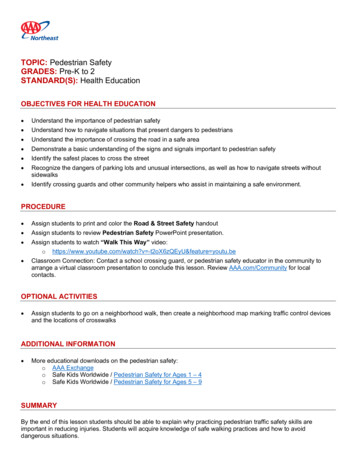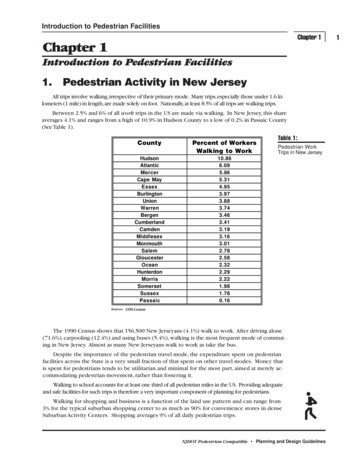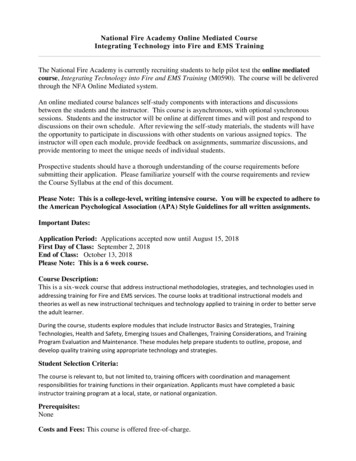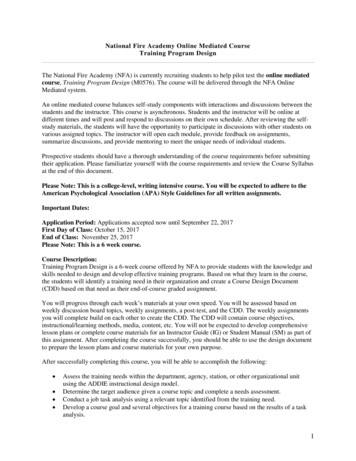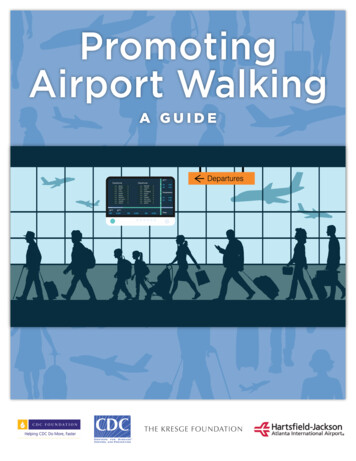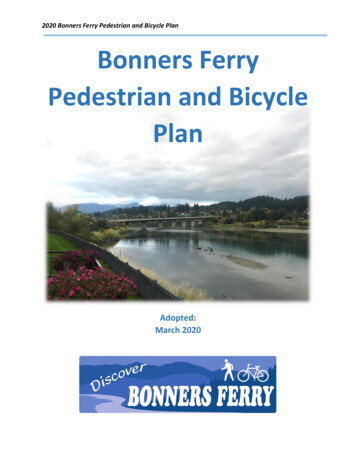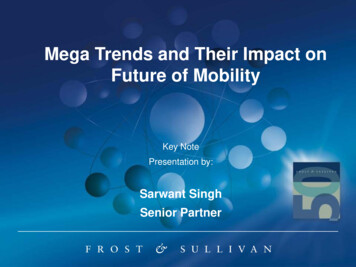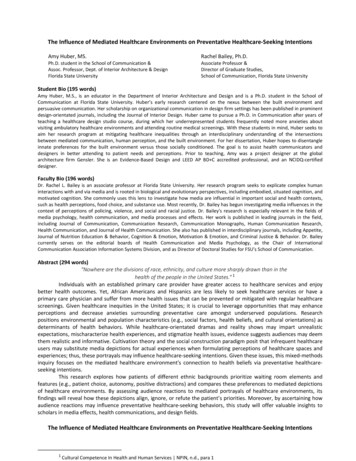
Transcription
Mediated pedestrian mobility: walking and the map appEric Laurier,Institute of Geography,School of GeoSciences,University of EdinburghEdinburgh EH8 9XPeric.laurier@ed.ac.ukBarry BrownMobile Life CentreSE-164 29 Stockholm, Swedenbarry@mobilelifecentre.orgMoira McGregorMobile Life CentreSE-164 29 Stockholm, Swedenmoira@mobilelifecentre.orgAbstractWhile walking has always been mediated, the arrival of smartphones withmultiple apps has changed how we walk and how we use apps. In this paperwe investigate the relationships of pedestrian-in-the-street and app-user-onscreen actions. We display and describe a series of intersubjective practicesconstituted by, and with, walking while using a mobile device. The video dataused is from a larger study of pedestrians using smartphones in urban settings,with our analysis here turning on how a smartphone is used and interactedaround to accomplish walking together. Our approach draws uponethnomethodological conversation analysis (EMCA) studies of the sequentialand category-based organization of mobile and on-screen actions. The analysisshows how walking actions (such as unilateral-stopping, turning, re-starting)are connected to map actions such as displaying the map, manipulating thescale, and monitoring the movement of the you-are-here dot. We concludewith remarks on the collaborative inter-subjective nature of walking with apps.Keywords: walking, smartphones, map apps, wayfinding, action sequences,conversation analysis, ethnomethodology1
IntroductionPedestrians don't just walk. They rush, they dawdle, they stroll, they amble, they circle, they pause,they stop, they edge past, they saunter, they plod, they advance, they retreat, they backtrack, theylead, they follow. Walking happens as a host of more prepositional, intentional and consequentialactions: they walk toward, they walk away, they walk off, they walk into. Nor do pedestrians makenaked contact with the places where they are walking: hiking shoes protect their feet whilehillwalking, price tags and labels shape their trajectory while shopping, podcasts envelope them incomic dialogues while they walk to work.In this article, we pursue and extend, then, the idea of that there is no such as thing as walking-initself. Our goal is not to produce ‘the differential configurations of self and landscape’ (Wylie 2005:336) but rather to move toward the intersubjective production of mediated mobile practices. Ourpractices of walking in the city are not all the same, nor are they the same as walking barefoot in thepark. They are mediated by the ancient technologies of shoes, pavements and pedestrian crossings.We walk around the supermarket with a shopping list (Cochoy 2008), stand at a bus-stop readingthe timetable (Watson 2009), move around art galleries in relation to an exhibit (vom Lehn 2013)and stand for a while in the street pausing to listen to a busker (Smith forthcoming). How we movethrough places on foot has been further transformed by the arrival of various new technologicalsystems and their related media. The smartphone looms large as a device that we walk with, onethat introduces multiple kinds of media into pedestrian practices. One of the significant ‘new-yetold’ media that it has brought to walkers is the map. The map app departs from pedestrians’ preexisting paper maps in several ways: map apps have a ‘you-are-here’ dot and provide suggestedroutes between points, map apps can be re-scaled and rotated to align with the compass orientationof the device and they integrate with online search engines. They allow their users to drop pins andother markers into the map, to show them where things are in relation to their current location.Walking is seldom somnambulistic: to be moving your feet at all is also to be taken to have a reasonfor doing so. When the customer walks up to the counter they are taken to be about to pay for theirgoods. Walking, then, not only glosses over the myriad forms of pedestrian movement, it glossesover the intended actions that constitute pedestrian practices. Austin's (1962) ‘How to do thingswith words’ was a landmark lecture series in how it explored language not as a referential system formaking true/false statements, but as something we do things with. Research on mobility has builtupon Austin and others’ work in considering the performative role of mobility yet has missedAustin’s careful differentiation of what specific ordinary words do. For instance, in his discussionsof truth statements he examines the varying effects if three words that are commonly used in thosestatements (e.g. ‘entails’, ‘implies’ and ‘presupposes’). In this article we deepen Mobility Studies’engagement with Austin’s work by considering how pedestrians do things with walking while neverletting go of how walking is done with things.In what follows, we will examine how the practice of walking is central to reading the map app andhow the of reading of the map app is reflexively, if asymmetrically, tied to the walking. Throughexamining pedestrians walking together we will explore how walking plays its part in makingrecognisable to one another what is happening on a moment-by-moment basis, whether each andother knows where they are going and where each and other will go next. Specific features ofwalking actions such as pace, trajectory, halts, turns and so on provide resources for making sense ofthe map together, and showing the sense we are making of the map since pedestrian movement isitself inscribed into the map. GPS technology places a ‘you-are-here’ dot on the map, it scrolls the2
map and it is drawn upon to establish the scale. As Frith (2012) puts it, the map apps allow aninversion of the classic state cartography. Rather than the states predetermining how the world willappear on the map, the users of map apps, in interactions with their algorithms and interfaces,establish the centrepoints, scales and layers of their own maps, and they do this on a moment-bymoment basis.Doing things with walkingWhile Ryave and Schenkein (1974) opened their classic study of “doing walking” with a briefmention of ‘crawling, hopping, running, cartwheeling, jumping, skipping’ (1974, 265) they settledon navigation and the reflexive production and recognition of pedestrians walking together as theirmain focus (Ryave & Schenkein, 1974). We can, however, garner hints of the actions produced bywalking in their remarks on how single persons carefully manage their movement on the pavementto avoid being seen as doing activities like ‘following’ or ‘joining’. Their work was picked up almosttwo decades later by Lee and Watson’s (1993) studies of pedestrians in street markets, boardingtrains and navigating crowded stairways. Lee & Watson described how walkers, by their generalpositioning in relation to one another and relevant features of the environment, produce ‘flow files’and undertake pathfinding. Moreover they demonstrated how walking in public produces a moralorder manifest in the accountability of pace and preferences for minimizing disruption to movement(Lee & Watson 1993).It is only recently that these early studies have been returned to, in part as a response to the rise ofmobility studies and how mobility then features in embodied practices (see the collections(Haddington, Mondada, & Nevile, 2013; McIlvenny, Broth, & Haddington, 2014). Growing outof ethnomethodology and conversations analysis (EMCA) the contemporary studies have closelyexamined how talk, gestures, objects and environments are interwoven with courses of action. Thisturn toward mobility has been through undertaking studies of the vehicular, or, to put it anotherway, how people do things with, and through, moving as a vehicle. The vehicular units in questionmight be pedestrians entering a building (Weilenmann, Normark, & Laurier, 2014), a coupletravelling by car (Mondada, 2012), a small aircraft landing (Nevile, 2004) or a couple doing LindyHop (Broth & Keevallik, 2014). Across these varied settings the studies have been concerned with,firstly, how people jointly coordinate and accomplish their mobility on a moment-by-moment basisand, secondly, how they do this as particular categories of social unit.In terms of the moment-by-moment organisation of action, the classic ethnomethodologicalquestions of 'why that now?' and 'what next?' have, in a number of these studies of movement, beensupplemented with 'why that here?' and 'where next'? For the vehicular unit in motion, by their verymovement through the environment, they have a constantly changing 'here' which then alsoprovides changing access to events and to perspectives. Motion also shifts the proximity anddistance of the features of the environment, for driving: side streets, exits, entrances (Haddington &Keisanen 2009) or, for supermarket shopping: aisles, freezer units, bakery counters and bargainbaskets. Concomitantly by their ongoing movement, each unit has changes in their sequentialgeography of where they have just been and could possibly go next.Sensitive to the situated nature of walking as action, EMCA studies have examined how thecategory of the unit itself produces distinctive ways of walking while also being reflexivelyreconfigured by those mobilities. In considering the social categories of the mobile unit we arereturned to the premise of theories of walking and just as there is nothing that is walking-in-itself,walkers are never just walkers (Mondada 2012; Broth & Mondada 2013; De Stefani & Mondada3
2014). It is not just that walkers are themselves different categories of group (e.g. traffic wardens,office workers, museum visitors) – they undertake varied practices that then shift theircategorisation, so that in the case of museum visitors they may shift from touring the exhibits, tobrowsing in the museum shop and then on to standing together in the museum restaurant queue.By doing so they shift from producing, being recognized and responded to as visitors, to shoppersand then to diners.The recent EMCA studies have shifted the emphasis from the early studies interest in the ongoingmaintenance of walking together to the various reconfigurations that happen when groups do thingslike 'moving off' or 'moving on' (Mondada 21012a; Broth & Lundström, 2013; Lehn, 2013). Theongoing configuration of the relative positions of group members and their talk mutually elaborateone another so that, for example, in de Stefani’s (2013) study of supermarket shopping, onemember of a joint unit can announce that he is going to get the bread by himself, begin to departand thereby temporarily break the pair into two solo shoppers. What de Stefani highlights is thatthis is joint mobile action and that rather than the one who has departed being able to thereby dowhat he intended or not, next actions are oriented toward and being responded to by the other partyin parallel or subsequently. In de Stefani’s case, when one shopper departs, the other shopper doesnot stand still, but instead ‘walks beside’ without a word uttered. An incipient departure forchoosing bread alone is cancelled by a walking action that means the bread will be chosen together.Through studies of couples and friends shopping togetherIt is not that walking actions need to beinfinitely varied, de Stefani shows how such simple mobile actions as ‘stop’ and ‘go’ are central tothe mutual intelligibility of shopping as a pedestrian vehicle. In this article, we draw upon andextend these EMCA studies to consider how walking actions are used by wayfinding tourists inrelation to mobile media.Mediated walkingThere is a long history of the mediation between the walker and the ground, most obviouslythrough boots and shoes but also through tracks, roads and pavements (Ingold 2004; Michael2000). For the walker in the city, not only is the very ground smoothed and shaped to allow them tolook up from their footing (Ogborn 1998), they are surrounded by a multitude of urban signage andadvertising, as sketched out by Latour (2003) in his study of Paris. In it, he documents a citybristling with street signs, optical devices, receipt slips, guidebooks and more; Latour’s meditationon the mediation of Paris preceded the widespread adoption of the smartphone by urbanpedestrians. The phone has brought to our lives in public spaces, new forms of encounter and newforms of co-presence (Licoppe, 2013). It has facilitated game-playing on the move and thusbrought a changed way of playing together (Richardson, 2013), some games making 'remote' othersco-present with the pedestrian (Southern, 2012). Map apps on smartphones arrive on the shouldersof a longer pedestrianisation and transformation of media, introduced through the use of newmobile devices. The transfer of telephony to the walker through the mobile phone brought its ownchanges to the assumed location of both the caller and the called (Ling, 2004; Weilenmann 2003).Mobile phones also brought SMS text messaging and consequently new practices of writing andreading as forms of being together with remote others (Harper et al 2006).Walking through crowded urban spaces (or equally through empty rural spaces) has becomehybridised with a series of practices previously found in other spaces: listening to music, gossipingwith remote friends or ordering tonight's dinner (Frith, 2012). As the smartphone has enfoldedfurther digital media (e.g. Google search, Wikipedia, Youtube, Yelp) it has brought ever morepractices to pavements: searching, checking recommendations, playing games and, as we focus on inthis article, following maps (de Souza e Silva & Sutko, 2011; Brown et al 2015). The very walking4
of the vehicular unit is registered in the media by the system, a delegation of the work that adiligent map reader might have undertaken with pencils, compass, street signs and landmarks.Meantime the mobile device is not only tracked by GPS and made sense of by the system; thewalkers take it out of their pocket, raise it close to their eyes, show it to or hide it from otherwalkers. As we noted above, the device itself has a mobility in relation to the talk, gestures andcourses of action of the walkers. Our interest is in map practices now remediated by the map app,the movements of smart-phone itself and how map apps are then occasioned in particular wayswithin the pedestrian practices of wayfinding.Wayfinding accomplished through mediated walking practicesAs a walking unit, tourists move through the city in distinctive ways while also drawing upon theirindividual and relative mobility as a resource. For example, while one member of the group stops toconsult the guidebook, other members can walk around inspecting the surrounding environment forstreet names, information signs, landmarks etc. (Laurier & Brown 2008). By the member'spedestrian practices of ‘walking away’ from the immobile guidebook-reader the other members ofthe group categorise themselves as ‘doing reconnaissance’. Having walked away to examine thesurrounding environment, there are then expectations that they will return with informationrelevant to their wayfinding task.It may not be initially clear the difference that walking as a particular mode and materialarrangement of mobility makes to wayfinding with map apps. To turn briefly to GPS navigationsystems in cars, while this is obviously a vehicular social unit moving together, the car passengershave fixed relative positions that are not easily interchangeable. The GPS units are usually also fixedto the dashboard as part of the ecology of the car interior. Once car travellers are settled into theirseats they stay in them. From their relative positions, drivers and passengers can gesture with eyesand hands, turn their heads, and lean their torsos, but they are otherwise restricted in their mobilityin relation to one another (Brown & Laurier, 2012; Haddington & Keisanen, 2009). Pedestriansusing a map app on a smartphone are a different entity because they have distinctive embodied waysof walking together. They can individually ‘stop’ and ‘go’, change their relative pace thereby 'fallingbehind' or 'rushing ahead’; they can adjust the gap between their bodies, they can break apart theirvehicle to let other pedestrians through or shift from side-by-side to single file to pass throughnarrow gaps or doors (Conein, Félix, & Relieu, 2013). The device itself can be moved into and outof pockets and bags, closer and further away from eyes, tilted toward or away from the other walkerand so on. With the new resources that map apps provide, they require different sorts ofintersubjective mobile inquiry and are still settling into how we way find and way fare. We hopethen in what follows there will be some novelty in examining how a particular map app is drawnupon and itself re-drawn during practices of walking as tourists in the city.MethodologyThe recent generations of lightweight video cameras developed for extreme sports have leantthemselves to changed recording techniques for moving cameras with mobile subjects (see Brown etal. 2008; Spinney 2011). Following multiple camera techniques developed by McIlvenny (2013), forrecording cyclists, we asked our project participants to each wear cameras that sat on their chests.While for McIlvenny’s cycling studies, bicycle frames and riders’ helmets provide several points forattaching cameras to then capture forwards, rearwards and sideways angles, we did not want tooverburden our participants with cameras. Consequently each project participant had only onecamera which then captured a chest height view ahead but also allowed us to work out the5
orientation of their torso, their direction and speed of walking. Depending on their orientationtoward one another it produced recordings of each other body orientations and gestures from timeto time. Other researchers (e.g. Licoppe & Figeac, 2013) have used camera glasses that bettercapture head movements, glances, other gestures and inspection of smartphones at head height.However our preference was for the better quality images produced by sports cameras and they alsoallowed us to feed a lapel mic into them for better sound quality. The major drawback of our set-upis that we seldom see facial expressions and miss a number of gestures, objects and elements of theenvironment that will have been in the moving visual field of the participants. Not all of theseabsences are solved by camera glasses however because these cameras move with the head ratherthan the eyes of participants. During our data gathering we also installed screen capture apps on ourparticipant’s own phone or provided them with a project phone with the software already installed.The recordings from the cameras and screen capture were transcribed as graphic transcripts (Laurier2014). The format merges elements of the Jeffersonian conventions for transcribing conversationswith those of graphic novels. Where speech bubbles overlap, participants’ speech is overlapping.Equally where speech bubbles are placed far apart this indicates gaps between speaking. Thetemporal precision of textual transcripts is sacrificed in favour of, both the ease of reading of graphictranscripts and, more importantly, the visual details that they allow readers to register withoutlengthy textual descriptions.We recruited 15 participants in the cities of Stockholm and London, 5 of these were individualsand 5 were couples or friends. Our set-up for gathering data was a hybrid of classic task-basedwayfinding experiments and ethnographic studies of map use. The study participants were asked togo on a ‘typical day out’ which was convergent with what they were planning to do when they wererecruited. We collected 24 hours of video data that was then edited into smaller fragments aroundwayfinding events and the use of map apps. The fragment we will draw upon in this article is aspecimen, which is rich in material for analysing the interconnection of walking actions and themap app. It involves two American tourists, (‘Carol’ and ‘Dani’) realizing that they have made amistake while walking toward a destination for lunch, and then repairing their mistake byconsulting the map app.1. Walking as merely walking and checking the routeAs we have argued above, when people walk alone or together it involves much more than simplywalking together side-by-side. Questions of where walkers are going next, who knows where thegroup is going next and whether they are more or less lost, are posed and answered through thecombination of talk and walking actions. The production and recognition of one another’s walkingactions involves adjustments of pace, changes of direction, starting and stopping. In this first sectionwe will examine the walking actions of the tourists where their pace and direction simply continuesthe journey itself.The map app on Carol's smartphone has been used earlier to plan their route, identifying a short listof landmarks and street names. The underground stations along the main street that they arewalking past were picked out as landmarks. In passing (or not passing) the landmarks that wereearlier identified, the map is then made sense of in a reflexive relationship with the journey thatthey are making (Liberman 2013). Consulting the map is shaped by the very features of the urbanenvironment that were picked out on each earlier consultation of the map app.6
By virtue of having her smartphone out and checking the map app at the outset of their journey,Carol has also become accountable for this planned route. Wayfinding in groups, be they formallike a ship’s crew or informal like friends on a day out, involves distributing labour andaccountability. Carol has acquired the responsibilities of being the map reader and beingaccountable for that as part of their journey in search of lunch. However, while these responsibilitiesremain potentially relevant during the journey, whether the walkers shift in and out of their mapreading incumbency depends upon the other things they are doing amidst the walking activity.Walking in the city has a permeable quality because many other activities to seep into it.In Transcript 1, Carol & Dani are approaching the entrance to an underground railway station. Thecamera angle is forwards from Carol’s mid-riff. The station entrance is on the street corner justbeyond the red carpet entrance. Dani is walking on Carol’s right hand side, out of shot.Transcript 1. Walking together, checking and showing smartphoneClosing in on the station entrance coincides with a lull in their conversation. Carol, by shifting theposition of her smartphone, initiates a new course of action around the smartphone, which bringsback her incumbency as map reader. However, for Dani (on the right), what is being initiated is notimmediately apparent, given that there is an array of actions that may be initiated by raising asmartphone – such as answering an incoming call, checking a text message, taking a photo,checking email and, of course, checking the map. In continuing her gesture by then angling thesmartphone toward Dani, Carol offers what is on screen for Dani. She then goes on to say, ‘ohwe’re at this one’, the oh-preface marking an epistemic change (e.g. it’s a discovery that they are atthis underground station). The referent of ‘this one’ being established by the timing in relation to:what they are currently walking past and her pointing over the screen at a station on the map (seeTranscript 2). Dani has only minimal involvement, which is unsurprising considering her distancefrom the screen. Carol had to move the smartphone close to her eyes to inspect the map app closelyenough to read road names etc. By contrast Dani merely glanced at the smartphone screen when itwas tilted toward her in Transcript 1, the distance combined with her glancing indicative of justsuch minimal involvement.7
Throughout this checking of the smartphone there is no change in the pace or direction of theirwalking and, in that sense, the journey continues onward without alteration or correction. WhatCarol’s comment, ‘so we’re close’, accomplishes is preparing the pair of them for the more detailedchecking and approach-work that will be required on reaching their destination. The walking hasshifted from walking past one landmark after another, to walking toward their journey’s finaldestination. In sum, we have seen how the media is drawn upon smoothly to maintain continuouswalking while wayfinding work is undertaken. Things however do not continue to be so smooth.2. Unilateral stoppingFor pedestrians walking together in the city, coming to a halt jointly without a verbal request is partand parcel of walking as a group. Pedestrians stop at the edges of roads when they cannot cross,they stop to take photographs, to let people pass or make their way through entrances and exits(Weilenmann et al. 2014). Closely coordinated stopping is possible because of the walkers’ sharedaccess to the many features of, and events in, the environment that call upon them to pause theirjourneys or stop travelling entirely. In fact, between Transcript 1 and Transcript 2 Carol and Danihave just passed through one of the most common urban features which make stopping relevant:the edge of the pavement where it meets the road.Carol and Dani are advancing together continuously until Carol unilaterally stops (see Transcript2a). Stopping walking can be done more or less abruptly and we have examples in our corpus ofwalking coming to a gradual stop. Here, when Carol stops, she stops sharply. Had she produced herstop more gradually then Dani might still have stopped in tandem with her. Moreover she is not ata point where stopping was already spatially relevant (e.g. the earlier edge of a pavement).Transcript 2a: Unilateral and sharp stopping by CHowever Carol’s stopping is neither quite as abrupt nor unannounced as it might seem from Danihaving missed it and walked on for several steps. Having checked her smartphone, Carol did notput it away and was still inspecting it as they crossed the road, having had to restart the maps app(we will look at that in more detail below). Moreover, the stop is pre-figured by an audible sigh.From the sigh, Carol then further prefigures difficulties by an ‘uh’ which Dani also produces inoverlap (panels 2 and 3 of Transcript 2a). It may be that Dani’s ‘uh’ precedes a question in responseto the sigh over what Carol’s difficulties are. In addition, Carol had mentioned that they were ‘close’to their destination and it may be that Dani then anticipates problems around locating theirdestination given they have never been to it before so do not know what it looks like nor where it is.Carol begins to account for her unilateral stop by saying ‘we went too far?’ (panels 3 & 4). Thequestion is an account, which fits nicely with an immediate stop, which could itself precede turningback on their path as a likely next walking action. Carol’s querulous tone may mark her own8
scepticism over what she has seen on the map app given that she had not detected any problems onpassing the train station only three minutes earlier. Dani on hearing the question turns tightlyaround to re-orient herself both to a backward direction from their previous ongoing trajectory andto create a face-to-face spatial formation with Carol (see Mondada 2012a on changing formations).While unilateral stopping can accomplish various things, the responses to it are limited. The otherwalker(s) can also then stop or can continue walking. In de Stefani’s (2013) work on supermarketshopping, when one shopper stops to inspect goods the other can continue ahead or also stop andjoin them in inspecting their goods. For the wayfinders, when the map reader stops, the othermembers of the party best not continue given that it is quite whether they should be walking aheadat all, that is in question.3. Walking as a you-are-here dotMap applications on smartphones (‘map apps’ such as Google Maps) have brought the you-are-hereblue dot into common use. In the process, the previously fixed ‘you-are-here’ dot now moves acrossthe map as its users move through the environment. Map apps depart from older paper maps inseveral other ways: they provide maps that can be re-scaled and rotated to align with the compassorientation of the device. We might expect that this combination of the locational resources of theyou-are-here dot and the auto-rotation of the map would allow us to easily locate where we arewhile our journeys progress, given that they do the work of alignment of the map with theenvironment for us. Yet these very manipulation of media require further sense-making (Laurier &Brown, 2008) and the things that we do with maps when we are on the move are much more thanlocating where we are (Brown & Laurier, 2005).Part of the reason that a unilateral stop occurs is that Dani does not have shared visual access to themap app. Before the unilateral stop, if we look at what was happening on Carol’s screen, the mapapp had restarted, and Carol had re-typed the search term for the destination they had agreed uponearlier (panel 1 of Transcript 2b). The map re-appears on her map app when they are mounting thepavement. Carol was sighing, perhaps due to having to type their destination for a second time,when the map app restarted. The problem pre-figuring ‘uh’ occurs when C sees the red pin of theirdestination shift on the map app (see transcript 2b inset boxes). It is this change of state on the mapapp that Carol responds to with a sudden unilateral stop.Transcript 2b: The you-are-here and destination dotsOn each check of the map, Carol checked that their dot has moved further along their route, whichis up the yellow street, prominent in the middle of the map. The trouble that Carol detects is thatthe red destination pin has shifted from being above the you-are-here blue dot, to below it. Inresponse to the trouble Carol both lifts the device closer and pinches to zoom into the map for moredetail. However, as we note
engagement with Austin's work by considering how pedestrians do things with walking while never letting go of how walking is done with things. In what follows, we will examine how the practice of walking is central to reading the map app and how the of reading of the map app is reflexively, if asymmetrically, tied to the walking. Through
